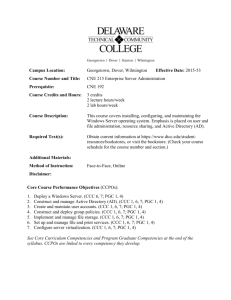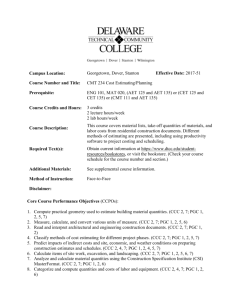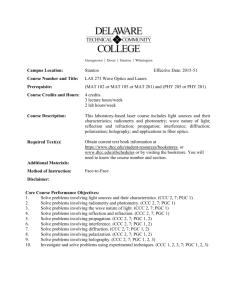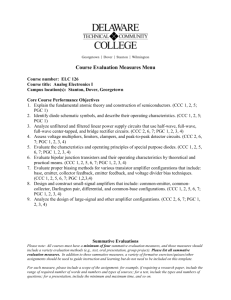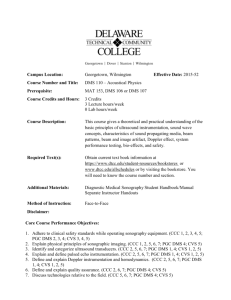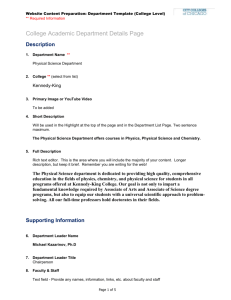Campus Location: Stanton Effective Date: 2016
advertisement
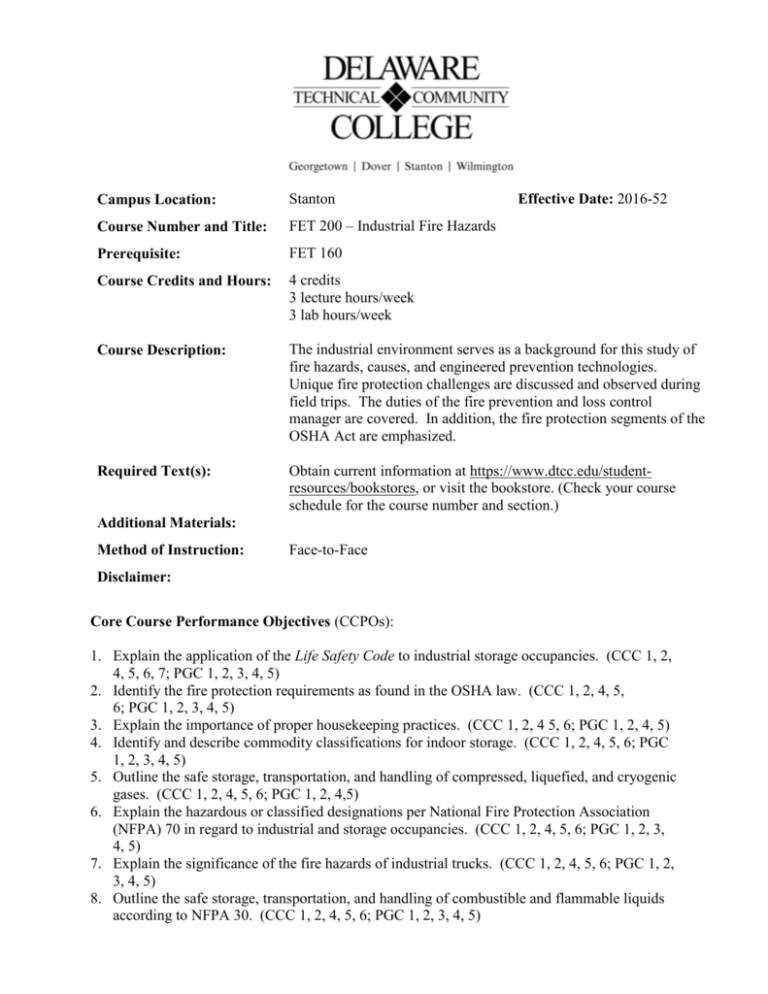
Campus Location: Stanton Effective Date: 2016-52 Course Number and Title: FET 200 – Industrial Fire Hazards Prerequisite: FET 160 Course Credits and Hours: 4 credits 3 lecture hours/week 3 lab hours/week Course Description: The industrial environment serves as a background for this study of fire hazards, causes, and engineered prevention technologies. Unique fire protection challenges are discussed and observed during field trips. The duties of the fire prevention and loss control manager are covered. In addition, the fire protection segments of the OSHA Act are emphasized. Required Text(s): Obtain current information at https://www.dtcc.edu/studentresources/bookstores, or visit the bookstore. (Check your course schedule for the course number and section.) Additional Materials: Method of Instruction: Face-to-Face Disclaimer: Core Course Performance Objectives (CCPOs): 1. Explain the application of the Life Safety Code to industrial storage occupancies. (CCC 1, 2, 4, 5, 6, 7; PGC 1, 2, 3, 4, 5) 2. Identify the fire protection requirements as found in the OSHA law. (CCC 1, 2, 4, 5, 6; PGC 1, 2, 3, 4, 5) 3. Explain the importance of proper housekeeping practices. (CCC 1, 2, 4 5, 6; PGC 1, 2, 4, 5) 4. Identify and describe commodity classifications for indoor storage. (CCC 1, 2, 4, 5, 6; PGC 1, 2, 3, 4, 5) 5. Outline the safe storage, transportation, and handling of compressed, liquefied, and cryogenic gases. (CCC 1, 2, 4, 5, 6; PGC 1, 2, 4,5) 6. Explain the hazardous or classified designations per National Fire Protection Association (NFPA) 70 in regard to industrial and storage occupancies. (CCC 1, 2, 4, 5, 6; PGC 1, 2, 3, 4, 5) 7. Explain the significance of the fire hazards of industrial trucks. (CCC 1, 2, 4, 5, 6; PGC 1, 2, 3, 4, 5) 8. Outline the safe storage, transportation, and handling of combustible and flammable liquids according to NFPA 30. (CCC 1, 2, 4, 5, 6; PGC 1, 2, 3, 4, 5) 9. Select the appropriate and required fire protection necessary for specific industrial fire hazards. (CCC 1, 2, 4, 5, 6; PGC 1, 2, 4, 5) 10. Explain the importance of fire extinguishers in the overall fire protection plan of an industrial or storage occupancy. (CCC 1, 2, 4, 5, 6; PGC 1, 2, 4, 5) 11. Identify the chemical and physical properties of fire extinguishing agents. (CCC 1, 2, 4, 5, 6; PGC 1, 2, 4, 5) 12. Identify the uses and limitations of fire extinguishing agents. (CCC 1, 2, 4, 5, 6; PGC 1, 2, 4, 5) 13. Select appropriate specialized systems and extinguishing techniques. (CCC 1, 2, 4, 5, 6; PGC 1, 2, 3, 4, 5) 14. Explain the control of hazardous vapors in the built environment. (CCC 1, 2, 4, 5, 6; PGC 1, 2, 3, 4, 5) See Core Curriculum Competencies and Program Graduate Competencies at the end of the syllabus. CCPOs are linked to every competency they develop. Measurable Performance Objectives (MPOs): Upon completion of this course, the student will: 1. Explain the application of the Life Safety Code to industrial and storage occupancies. Define the hazards of contents for industrial and storage occupancies of NFPA 101. Explain the NFPA 101 requirements for industrial and storage occupancies. 2. Identify the fire protection requirements as found in the OSHA law. Explain the applicability of the OSHA requirements as it relates to businesses, employers, and employees. Select the appropriate subpart that details fire and life safety requirements. 3. Explain the importance of proper housekeeping practices. Explain the importance of management policies in minimizing potential fire situations. Identify situations of excessive fuel loading. Identify processes that may create environments where a combustible dust hazard could exist. 4. Identify and describe commodity classifications for indoor storage. Explain the type of storage as found in NFPA 13. Identify the evolution of the basic approaches to protecting an indoor storage hazard. Identify the basic design concepts of in-rack sprinkler systems. Explain commodity Class I, II, III, and IV. Explain the three plastic groupings. 5. Outline the safe storage, transportation, and handling of compressed, liquefied, and cryogenic gases. Explain the storage, transportation, and handling of compressed gasses. Explain the storage, transportation, and handling of liquefied gasses. Explain the storage, transportation, and handling of cryogenic gasses. 6. Explain the hazardous or classified designations per National Fire Protection Association (NFPA) 70 in regard to industrial and storage occupancies. Identify the class designations as they relate to flammable liquids/flammable gases, combustible dusts, and ignitable fibers. Identify the division designations as they relate to expected use of materials/chemicals. 7. Explain the significance of the fire hazards of industrial trucks. Identify the differing types of industrial trucks. Identify the classification system according to NFPA 505. Identify the approved/listed environments where industrial trucks are permitted. 8. Outline the safe storage, transportation, and handling of combustible and flammable liquids according to NFPA 30. Explain the storage, transportation, and handling of combustible liquids. Explain the storage, transportation, and handling of flammable liquids. 9. Select the appropriate and required fire protection necessary for specific industrial fire hazards. Identify the fire hazard of a spraying operation. Identify the fire hazard of a coating operation. Identify the fire hazard of a dip tank operation. Identify the fire hazard of a solvent reclamation operation. 10. Explain the importance of fire extinguishers in the overall fire protection plan of an industrial or storage occupancy. Identify the four factors that affect the effective use of a fire extinguisher. Identify the five classifications of fire and what extinguishing agents are effective for each class. Identify the standard markings for fire extinguishers. Identify the marking procedures for extinguisher locations. Identify the factors that affect the selection of an extinguisher. Select the proper operation and use of the different types of extinguishers (e.g., waterbased, carbon dioxide, clean agents, dry chemicals, dry powders, water mist, and foam). Identify obsolete extinguishers, and recommend replacements. Identify the placement procedures for extinguishers using the requirements as specified in NFPA 10. Identify the maintenance and inspection procedures for extinguishers. 11. Identify the chemical and physical properties of fire extinguishing agents. Identify the chemical and physical properties of carbon dioxide. Identify the chemical and physical properties of clean agent alternatives. Identify the chemical and physical properties of a dry chemical. Identify the chemical and physical properties of a wet chemical. Identify the chemical and physical properties of foam. Identify the chemical and physical properties of combustible metal agents. 12. Identify the uses and limitations of fire extinguishing agents. Identify the uses and limitations of carbon dioxide. Identify the uses and limitations of clean agent alternatives. Identify the uses and limitations of a dry chemical. Identify the uses and limitations of a wet chemical. Identify the uses and limitations of foam. Identify the uses and limitations of combustible metal agents. 13. Select the appropriate specialized systems and extinguishing techniques. Identify specific water-based fire protection systems used to minimize the risk from fire in an industrial environment. Identify specific gaseous agent systems used to minimize the risk from fire in an industrial environment. Identify specific chemical-based systems used to minimize the risk from fire in an industrial environment. 14. Explain the control of hazardous vapors in the built environment. Identify the location of appropriate ventilation equipment. Identify the necessary use of combustible gas or flammable vapor detection equipment. Evaluation Criteria/Policies: Students must demonstrate proficiency on all CCPOs at a minimal 75 percent level to successfully complete the course. The grade will be determined using the DTCC grading system: 92 83 75 0 – – – – 100 91 82 74 = = = = A B C F Students should refer to the Student Handbook (https://www.dtcc.edu/academics/studenthandbook) for information on the Academic Standing Policy, the Academic Integrity Policy, Student Rights and Responsibilities, and other policies relevant to their academic progress. Core Curriculum Competencies (CCCs are the competencies every graduate will develop): 1. 2. 3. 4. 5. Communicate clearly and effectively both orally and in writing. Demonstrate effective problem solving and reasoning skills. Work effectively in groups of people from diverse backgrounds. Demonstrate ethical and professional understanding and conduct. Apply appropriate information literacy skills to locate, evaluate, and use information effectively. 6. Use computer technology appropriate to the field. 7. Use scientific and mathematical reasoning appropriate to the technology. Program Graduate Competencies (PGCs are the competencies every graduate will develop specific to his or her major): 1. Use fire protection computer applications. 2. Analyze a set of building plans for compliance with pertinent fire protection codes and standards. 3. Specify fire rated building materials and assemblies for architects and contractors. 4. Inspect a building for compliance with fire protection codes and standards. 5. Deliver written and oral recommendations to business owners, industrial managers, and governmental officials. 6. Inspect and test fire protection systems including detection/alarm systems, suppression systems, and their appurtenances. 7. Detail the layout and calculation of an automatic sprinkler system.
